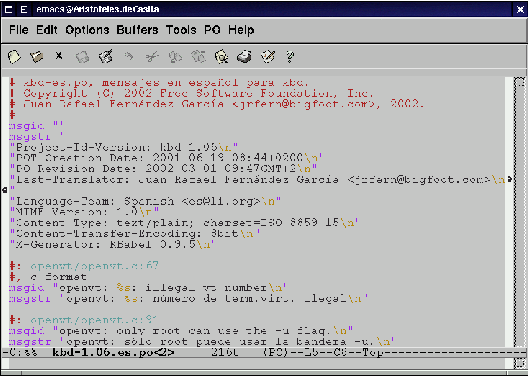En mi caso se me asignó el «dominio» kbd. [27]
The kbd textual domain
Here is a short description for the textual domain kbd. The current template for this domain is kbd-1.06.pot.
The maintainer does not require special papers prior to accepting translations.
The following URL information may help translators for this package, for if they need finer translation context, but the distributions might well be experimental, and might not even compile. Be well aware that the URLs given here are not necessarily official.
ftp://ftp.win.tue.nl/pub/linux-local/utils/kbd/kbd-1.06.tar.gz
The following table gives some information about PO files which are available for that textual domain.
Tabla 4.4. The kbd textual domain
| Code | Language | Version | Last Translator | Translated |
|---|---|---|---|---|
| fr | French | 1.06 | Michel Robitaille | 215 / 215 |
| es | Spanish | 1.06 | Juan Rafael Fernández García | 215 / 215 |
| sv | Swedish | 1.06 | Martin Sjögren | 215 / 215 |
| tr | Turkish | 1.06 | Nilgün Belma Bugüner | 215 / 215 |
Last recomputed on 2002-05-08 12:22 -0400.
Your comments are welcome.
Lo primero es obviamente descargar el fichero que hay que traducir, en este caso kbd-1.06.pot, y «visitarlo» con emacs. Podemos verlo en la figura 2.
Salva el fichero de trabajo como kbd-1.06.es.po. Traduce cada mensaje con la ayuda de emacs, como en la figura 3.
Cuando hayas terminado
[Mi_maquina]$ msgfmt -v -o /dev/null kbd-1.06.es.po 215 translated messages. [Mi_maquina]$
No ha devuelto errores, luego la traducción ha terminado.
Sólo falta enviarla al robot del proyecto. Basta un correo electrónico, en la cabecera
To Translation Project Robot <translation@IRO.UMontreal.CA> Subject TP-Robot kbd-1.06.es.po
En el cuerpo del mensaje se hallará el fichero .po. El robot responderá aceptando la traducción (si pasa una serie de pruebas) o señalando los errores que ha encontrado.

